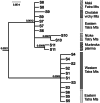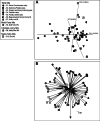Glacial history of Saxifragawahlenbergii (Saxifragaceae) in the context of refugial areas in the Western Carpathians
- PMID: 39346616
- PMCID: PMC11437128
- DOI: 10.3897/phytokeys.246.118796
Glacial history of Saxifragawahlenbergii (Saxifragaceae) in the context of refugial areas in the Western Carpathians
Abstract
Despite the wealth of data available for mountain phylogeography, local-scale studies focused on narrow endemic species remain rare. Yet, knowledge of the genetic structure of such species biogeographically linked to a restricted area is of particular importance to understand the history of the local flora and its diversity patterns. Here, we aim to contribute to the phylogeographical overview of the Western Carpathians with a genetic study of Saxifragawahlenbergii, one of the most characteristic endemic species of this region. We sampled populations from all discrete parts of the species' distribution range to apply sequencing of selected non-coding cpDNA and nuclear ribosomal DNA (ITS) regions, as well as Amplified Fragment Length Polymorphism (AFLP) fingerprinting. First, while ITS sequences showed weak diversification, the genetic structure based on cpDNA sequences revealed two well-differentiated groups of haplotypes. One of them is restricted to the main center of the distribution range in the Tatra Mountains (Mts), while the second group included a series of closely related haplotypes, which in most cases were unique for particular isolated groups of populations in peripheral mountain ranges and in the south-eastern part of the Tatra Mts. AFLP fingerprinting also revealed a pattern of divergence among populations, while only partly corroborating the division observed in cpDNA. Taking into account all the data, the pattern of genetic structure, supported by the high levels of unique genetic markers in populations, may reflect the historical isolation of populations in several local refugia during the last glacial period. Not only the center of the range in the Tatra Mts, but also other, neighboring massifs (Malá Fatra, Nízke Tatry, Chočské vrchy, Muránska planina), where populations are characterized by separate plastid DNA haplotypes, could have acted as separate refugia.
Keywords: AFLP; Tatra Mts; haplotype; high mountain plant; narrow endemic; phylogeography; refugial areas.
Elżbieta Cieślak, Michał Ronikier, Magdalena Szczepaniak.
Conflict of interest statement
The authors have declared that no competing interests exist.
Figures




References
-
- Benham J, Jeung JU, Jasieniuk M, Kanazin V, Blake T. (1999) Genographer: A graphical tool for automated fluorescent AFLP and microsatellite analysis. Journal of Agricultural Genomics 4: 1–3.
-
- Birks HJB, Willis KJ. (2008) Alpines, trees, and refugia in Europe. Plant Ecology & Diversity 1(2): 147–160. 10.1080/17550870802349146 - DOI
-
- Christe C, Caetano S, Aeschimann D, Kropf M, Diadema K, Naciri Y. (2014) The intraspecific genetic variability of siliceous and calcareous Gentiana species is shaped by contrasting demographic and recolonization processes. Molecular Phylogenetics and Evolution 70: 323–336. 10.1016/j.ympev.2013.09.022 - DOI - PubMed
LinkOut - more resources
Full Text Sources
